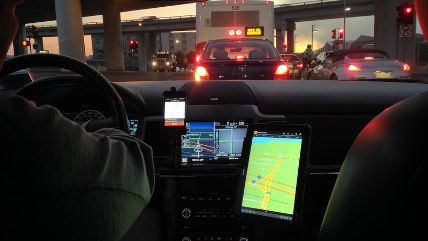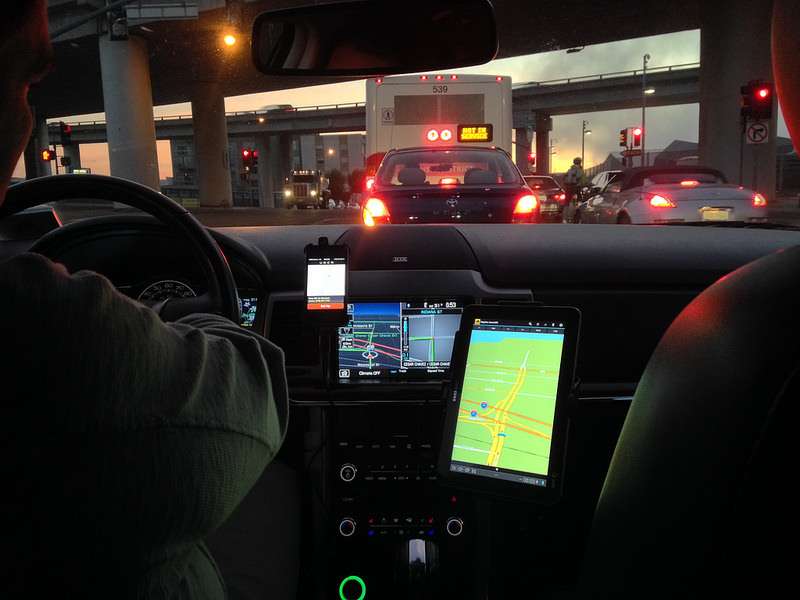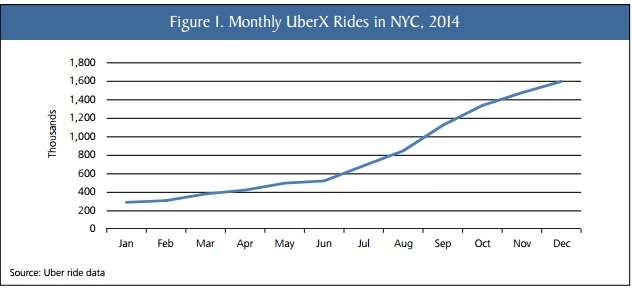Uber Seeing Increased Use in Poorer New York Neighborhoods
New study charts growth over 2014.


The urban policy-oriented Manhattan Institute got their hands on data for every single Uber-facilitated ride that took place in New York City in 2014, with the company's blessing. The goal, given the controversies over the use of ride-sharing services and their impact on the existing taxi industries, was to compare where UberX rides are coming and going. Who are they serving? Manhattan Institute Fellow Jared Meyer has released a report today exploring whether UberX has "expanded transportation options in NYC in 2014, particularly in low-income neighborhoods."
- UberX still a small fraction of yellow-taxi rides. UberX rides expanded dramatically, from 287,000 in January to 1,594,000 in December. However, the 9.5 million total UberX rides was equal to only about 5 percent of the city's 175 million yellow-taxi rides.
- UberX far less Manhattan-focused. Only 6 percent of yellow-taxi pickups were outside Manhattan or outside city airports—compared with 22 percent for UberX.
- UberX growing fast in low-income neighborhoods. Of UberX rides in noncore Manhattan and non-airport zip codes in December, 60 percent were in zip codes with median household income below the noncore Manhattan median—up from 54 percent in January.
- UberX serves predominantly nonwhite, as well as predominantly white, neighborhoods. In the 29 noncore Manhattan and non-airport zip codes with one or more UberX pickups per household, black households constituted 29 percent of all households, while the average for all 146 noncore Manhattan zip codes was 27 percent. The aforementioned 29 zip codes included neighborhoods ranging from Greenpoint and Park Slope—where less than 5 percent of households are black—to Crown Heights and Harlem, where more than 75 percent of households are black.
- UberX not concentrated at rush hour. Some 2.22 million UberX rides began during 10 am–4 pm, 4.26 million began during 7 pm–7 am, and 2.97 million, or 31 percent, began during rush hour.

At the same time Meyer was working through this data, Nate Silver and Reuben Fischer-Baum over FiveThirtyEight were doing their own study of Uber user data. On the surface, the two studies appear to contradict each other. FiveThirtyEight evaluates:
In New York overall, there isn't much difference between the people picked up by Uber and the ones who ride in cabs. Uber and taxis both disproportionately serve wealthy areas within Manhattan or just across the bridges and tunnels from it. What's more, these customers usually live in neighborhoods with abundant public transit access also. In other words, the combination of public transit and for-hire vehicles is something that New Yorkers have been relying on for years.
They provide a map that shows very similar use patterns for Uber cars and cabs. But upon further review, the two reports may not actually be that contradictory. Meyer got a full year of data. Silver only from April through September. Meyer acknowledges that, yes, the vast majority of Uber rides are serving Manhattan and Brooklyn. But as increasing numbers of people called on UberX for rides as the year went on, more and more of those calls were for customers in less wealthy parts of New York:
The data also reveal that of UberX's pickups in NYC's 146 noncore Manhattan zip codes during January 2014, 54 percent were in zip codes with household income below the noncore Manhattan median. During December 2014, that figure climbed to 60 percent. In other words, there were roughly 200,000 more UberX pickups in less affluent NYC zip codes in December 2014 than in January 2014.
Because Silver didn't have the whole year of data, he didn't have the full trend. Meyer concludes:
These findings indicate that ride-sharing services— notably, Uber—increasingly provide New Yorkers in lower-income and minority neighborhoods beyond core Manhattan with a service that complements city-authorized taxis. Further, these findings suggest that, although New York's standard taxi model serves the needs of many residents, ride-sharing is expanding the range of available for-hire vehicle service— thereby reducing inequities in service availability in NYC's transportation market. The beneficiaries include residents of neighborhoods that were previously underserved by available options.
Read his full report here.




Show Comments (323)